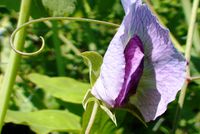Difference between revisions of "Capucijner pea"
From eagle-rock.org
| Line 13: | Line 13: | ||
First i loosened the soil and added 30 l/m2 worked-out compost to the top layer (peas don't like fresh manure). | First i loosened the soil and added 30 l/m2 worked-out compost to the top layer (peas don't like fresh manure). | ||
| − | [[File:Sowing Capucijner peas.JPG|120px|thumb| | + | [[File:Sowing Capucijner peas.JPG|120px|thumb|right|I sowed the peas in lines, 2 seeds together and on a distance of 10 cm.]] |
== Gallery == | == Gallery == | ||
Revision as of 08:34, 28 December 2011
Chunks of information
- Here's first some general information about this little-known pea: "During the late Middle Ages, Capuchin monks in Holland and northern Germany devoted considerable energy to the improvement of field peas for agricultural purposes. This has resulted in a group of large-seeded gray peas referred to as Capuchin, especially those from the Netherlands where the breeding of new pea varieties became a national pastime by the early 1600s. One of the classic peas from this group and one which dates from the 1500s is the handsome blue pod Capucijner, a soup pea growing on six-foot (two m) vines." - source
Diary sowing capucijner peas
This type of pea is rather rare, but I got some of these peas to try them out.
First i loosened the soil and added 30 l/m2 worked-out compost to the top layer (peas don't like fresh manure).
Gallery
See also
External links
- Capucijner pea Research Topics
- Pisum sativum (Blue Pod Capucijner Pea)



